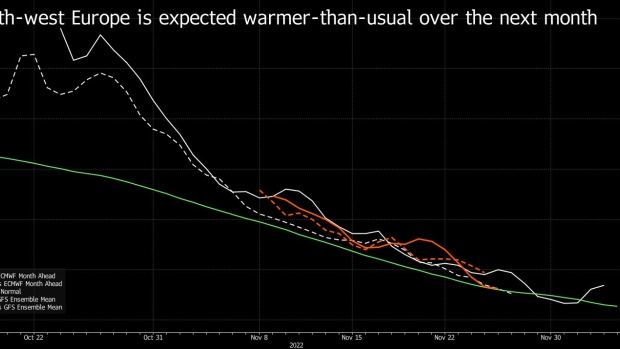Oct 24, 2022
European Gas Slumps to €100 on Mild Weather and Ample Supplies
, Bloomberg News

(Bloomberg) -- Natural gas in Europe dropped below €100 per megawatt-hour for the first time since June as unusually warm weather and ample supplies ease fears of shortages this winter.
Benchmark futures finished 13% lower on Monday, and have slumped more than 70% from the peaks of August. High temperatures are expected to remain into next month, delaying the heating season and allowing storage sites to continue to be filled. The fuller-than-usual reserves would provide the buffer needed for when the weather inevitably turns cold.
Read also: Europe Eyes Hot End to October in Relief for Energy Crunch
The improved conditions are easing some pressure on Europe’s policy makers, with the energy crisis helping push the economy to the brink of recession and inflation to the highest level in decades. Despite the recent dip, prices remain about three times higher than the five-year average for the time of the year, and cold snap could quickly renew supply concerns.
“Europe is in a comfortable place concerning supplies now,” said Graham Freedman, an analyst at consultancy Wood Mackenzie. “The risks of blackouts and rationing are receding. But the real test will be when we have cold weather.”
Dutch front-month gas futures, the European benchmark, settled at €99.17 a megawatt-hour, the lowest since June 14. The UK front-month gas contract fell 10%, while German power for next year also slid.
There remains a good chance of a further decline in prompt gas prices due to mild weather and a glut of LNG arrivals, together with a slowdown in demand, said Ole Hansen, head of commodity strategy at Saxo Bank A/S. But longer-term contracts are still trading above the current level. “It highlights the continued risk to supply next year,” he said.
European Union leaders have already agreed to back more measures to tackle the energy crisis, including supporting a cap on the price of gas in electricity generation and steps to avoid extreme spikes. The bloc’s energy ministers will meet this week to continue to hash out the details.
Click here to read the daily Europe Energy Crunch blog
There are also increased calls from member states for more action to protect the economy from high costs, even as the International Monetary Fund warned over the weekend of a “toxic mix” of rapid inflation and flagging growth in the region.
Navigate Winter
The high storage levels and imports to replace some of the lost Russian supplies will likely be enough to “navigate a normal winter,” Bloomberg Intelligence analyst Patricia Alvarez wrote in a note. “But curbing demand remains key in mitigating the impact of further Russian gas cuts.”
Pipeline shipments from Moscow have plunged to just about 20% of what they used to be before the war in Ukraine and subsequent sanctions on Russia. The loss of those volumes would make it harder for Europe to replenish crucial reservoirs at the end of winter, potentially making next year difficult as well.
But German Economy Minister Robert Habeck told Handelsblatt that the country would be in a much better position next winter than this one as more LNG flows in. Supplies from places including Norway and the Netherlands should make up about one-third of lost flows of the shut Nord Stream pipeline that carried Russian gas.
--With assistance from Elena Mazneva and Vanessa Dezem.
©2022 Bloomberg L.P.






